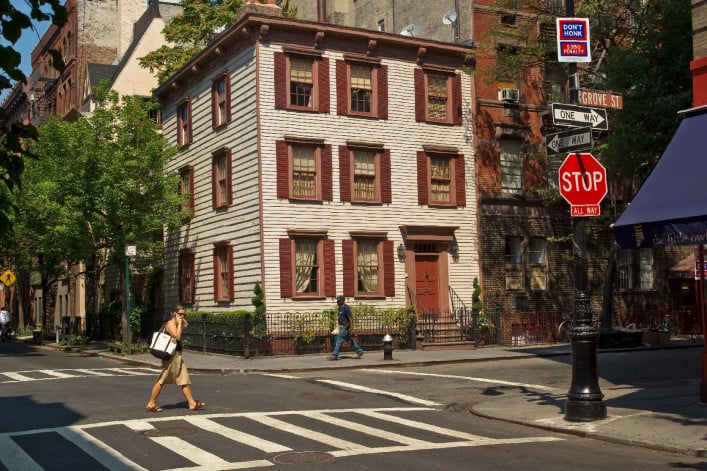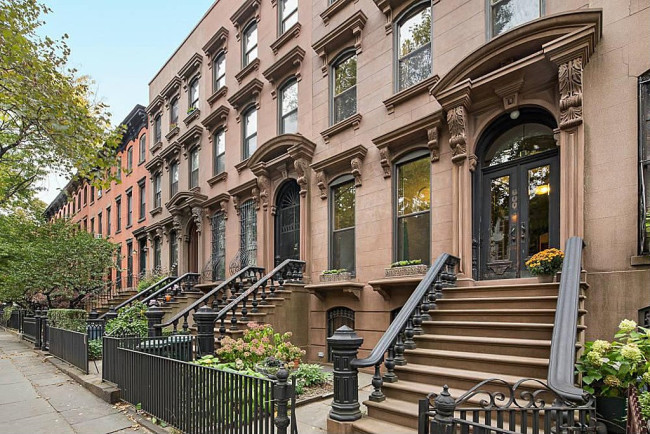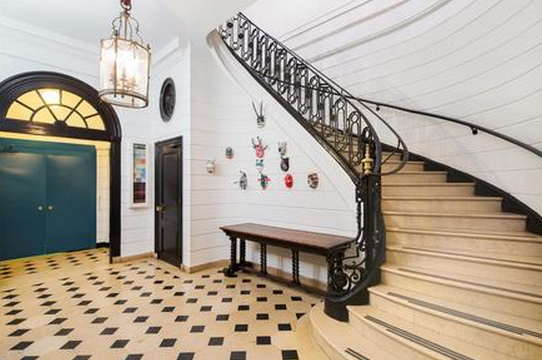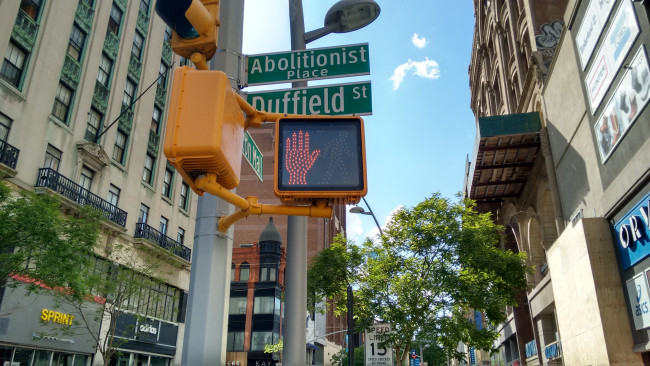Living inside history: What it's like to own—and update—a landmark property
Ask New Yorkers to define their city, and they'll likely tell you that a signature trait is its constant state of flux. And perhaps it's because gleaming new towers rise and beloved businesses vanish seemingly by the day that many locals fight fiercely to preserve a sense of the city's history. The Landmarks Preservation Commission, the agency that oversees the designation of historic districts and individual landmarks, has a map that reveals the city's many protected oases, like Murray Hill's semi-hidden Sniffen Court and the leafy enclave of Sunnyside Gardens, which shiny new development isn't allowed to touch.
Interestingly, the LPC was established in part in reaction to the demolition of a once-grand city space: The former Penn Station, which was torn down in 1963. This event, the LPC's site notes, led to a greater sense of urgency around the preservation of significant places in NYC.
Purchasing a slice of New York's past and becoming its caretaker, say landmark building owners, is a special kind of honor, but it's also one that presents plenty of challenges. Read on to learn about what to expect when you buy a home in one of the city's historic districts.
How landmarks are designated and preserved
First, you'll want to understand what NYC's types of landmarks are, and how these sites are protected. The LPC makes a distinction between individual landmarks, which it considers "standalone structures that have architectural, cultural, or historical significance," like Grand Central Station, and buildings within designated historic districts like the West Village, which add value and authenticity to the surrounding neighborhood.
Within the boundaries of protected places like the Greenwich Village Historic District, for example, all properties are automatically considered landmarks. Agustin Ayuso, an architect with Bolster (fyi, a Brick sponsor), explains that if you own a home in such a district, you'll need to do some research on what the exact historic value of your property is.
"When they create these districts, they list the reasons why, outlining historic qualities and the buildings that contribute to that history," he says. "Go to the LPC site and read up on your building. If there's nothing written, that means it just happens to be within a historic district. If it isn't mentioned, you are in better shape than otherwise."
Better shape to make alterations, that is. As the LPC's primary concern is maintaining the character of the areas it has designated landmarks, the agency must approve any major changes you want to make to your home.
"Any project that has to go to the Department of Buildings for permits also has to go through the LPC," Ayuso says. "Whether it's an interior renovation or changing the facade, it has to be seen and reviewed by the LPC before the DOB approves it."
The LPC issues three types of approvals for renovations to historic properties. The first is a Certificate of No Effect, which means that the proposed work will not impact the protected historic features of a building. A Permit for Minor Work means significant architecture will be impacted, but only in a small way—think window replacements. Both of these approvals can be issued by LPC staff and don't require a hearing.
A Certificate of Appropriateness, meanwhile, is more involved. This is required when a homeowner's proposed project will have a larger effect on their historic property, and requires the approval first of the local community board and then the LPC, via a public hearing—a process that could add two to four months to a renovation. (Curbed has a helpful guide to the process behind these hearings, as well as how to speak at one.)
Katherine Schoonover, who with her husband owns an 1842 Greek revival townhouse in the West Village, is well-versed in this process but says she understands its necessity—and that if you're renovating in a way that honors the property's history, you shouldn't encounter much of a struggle.
"It depends on whether you're doing something that's historically appropriate or not. If it's appropriate, it probably doesn't slow you down by more than a month or two to get the approvals," she says. "A lot of architects want to put their stamp on things, but that's not what I consider good preservation. When we did our restoration, we were trying to make ourselves invisible, and create a place where people would walk in and feel the house was found that way intact."
In her case, she and her husband were granted a Certificate of No Effect for their home restoration project, because it had already been so altered that there were no visible architectural features left to protect.
Ayuso says that that key to a smooth approval process is doing the legwork to ensure that your home remains true to its origins even as you update it. With exterior paint, for instance, the LPC might put the kibosh on a color like pink because it wasn't used during the time period when a particular home was built. "And they don't want you replacing a historic Tiffany light fixture with something for $30 from Home Depot," he notes—so do some research about your home's architectural vernacular and the era in which it was constructed.
On the other hand, sometimes it's impossible to adhere fully to LPC guidelines, because certain historically accurate materials may not be available anymore. "I've seen the LPC approve projects that go against guidelines before" for this reason, he says. "Every building is different."
Living in a landmark
Cassie Glover, who owns a 19th-century brownstone on Charles Street, says that investing in a historic property is "not for most New Yorkers who work fast or want instant gratification." When her family purchased the West Village property, it needed a total renovation, and she had to consult at length with the Greenwich Village Society for Historic Preservation (GVSHP) and the LPC.
"Everything we did, from repainting doors to rebuilding the stoop to fixing the roof to painting gates, all went in front of the LPC," she recalls. "It wasn't an easy or fast process."
However, Glover said her family was rewarded for their patience. "When we started peeling back paint and the industrial carpeting, we started finding things. We found the original mouldings and were able to replicate them. We found the original fireplaces in the basement in a stack and we had them repaired and put back in," she says.
Besides the intangible benefit of enhancing your home's beauty and sense of the past, there may be financial perks as well: historic district designations may lead to higher property values, even during tough economic times. Jonathan Miller of appraisal firm Miller Samuel cautions, though, that the boost may only be nominal, especially given the extra costs of renovating.
Schoonover and her husband also put in plenty of hours updating their historic home. When they bought the property in the 1980s, it had undergone several renovations already and was "the eyesore of the block," she recalls.
They set to work restoring the townhouse to its original glory, a project that unfolded in stages over the course of several years; they frequently met with staff at the LPC in order to obtain the necessary certificates. "I found the LPC to be mostly supportive, and the person who was our initial reviewer was very knowledgeable and helpful," Schoonover says.
She, too, found that the patience and close attention to historic detail that a property like hers requires to be well worth the trouble. She and her architect had trouble finding historically accurate windows to replace the existing ones, so they ended up having new windows custom made, a decision that was pricier but ultimately retained the property's character.
Homeowners like Schoonover, who invest in restoring historic homes, can find some financial incentives for the work in the form of tax credits, and the New York Landmarks Conservancy offers grants for certain types of rehabilitation of architecturally significant buildings.
"Yes, it's challenging to live in an old house because they need a lot of support, but I feel honored to live there," Schoonover says. "I feel like a caretaker of this beautiful building which now contributes to the historic district because it's been restored in an accurate way."
Glover agrees, saying she finds the West Village akin to the Metropolitan Museum of Art, for the way it has been so lovingly preserved. "This is history, this is worth keeping, it's worth the effort it takes. If we'd torn everything down, what would Manhattan be?" she wonders. "Let's not start erasing history to make new things."
You Might Also Like































